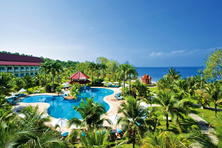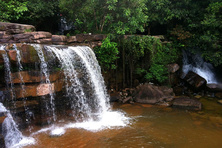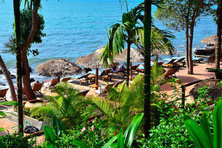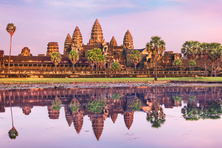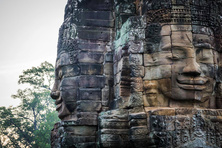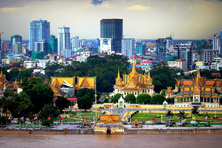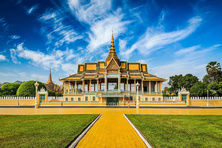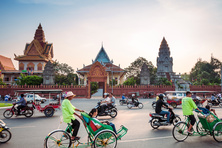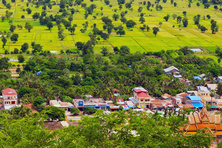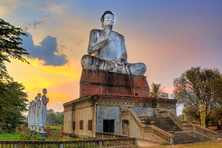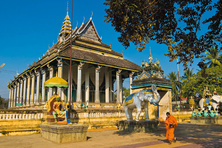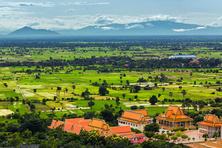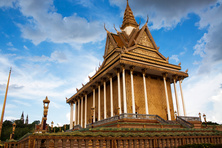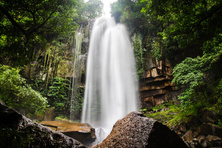Cambodia
- Currency: Cambodian riel
- Time: UTC+7
- Languages: Khmer
- Religions: Buddhism (Theravada)
- Sections: Get in Visa Customs Cuisine Money Details of interest Popular resorts
Cambodia or officially the Kingdom of Cambodia is a state in Southeast Asia on the Indochinese Peninsula. It borders Vietnam, Laos and Thailand. In the southwest, the country has a long sea coast of the Gulf of Thailand, which relates to the gulfs of the Pacific Ocean. The capital city is Phnom Penh.
Cambodia has a monsoon tropical climate. There are two seasons in Cambodia: hot and humid summer (from May to October) and not very hot and dry winter (from November to April). The beginning of winter is the best time for active tourism. The second half of winter better suits for diving. Beach season in Cambodia starts in the dry season.
The official language is Khmer, almost all people in Cambodia speak this language. Buddhism is the main religion.
Travel in Cambodia will be interesting for those who want to get to know the cultural heritage of the country. The main sight is the ancient complex Angkor Wat situated near the city of Siem Reap. In Cambodia, there are many more less famous, but also very impressive ancient monuments of civilization.
There are over twenty national parks which preserved the untouched diversity of the wild nature.
The lovers of active tourism will surely have a fun time in Cambodia. The divers can dive into the waters near the numerous islands of the Gulf of Thailand, for example, Koh Koun island and Koh Rong island. The tourists can fish anywhere in Cambodia but the most popular place is the lake Tonle Bati which is situated not far from the capital city.
Beach tourism is very well developed in Cambodia. The best resorts are in the Sihanoukville province and Kep province.
Unique and exotic Cambodian cuisine attracts the foodies. Many tourists stay for a longer time in the city of Koh Kong to gamble in local casinos.
Get in
By Plane
CIS and European countries do not have direct flights to Cambodia. The tourists can get to Phnom Penh and other cities through China, Vietnam or Thailand. The most convenient route for traveling to Cambodia is a transit flight with a stop in Bangkok, Ho Chi Minh City or Hong Kong.
By Land
There are highways connecting Cambodia with all the neighboring countries, so of you are staying in one of them and have a visa, you can get to Cambodia by bus or car. The buses run regularly between Cambodia and Vietnam and Thailand but buses from Laos are not regular so do not rely on them much.
Visa
Tourists from CIS countries and the European Union must obtain a visa to travel to Cambodia. One can submit the documents for a visa online or at the Embassy and on arrival at the Customs control point except the points on the border with Laos. It will take you about 20-30 minutes to get the visa on arrival.
One can get an e-visa submitting the documents on the website of the Ministry of Foreign Affairs of Cambodia. However, in this case, the tourists will be able to get into the country only through international airports in Phnom Penh, Siem Reap and ground crossing Bavet on the border with Vietnam, Cgam Yeam and Poi Pet on the border with Thailand. Online visa is given within 3 days. The citizens of the countries where there is the Embassy of Cambodia can supply the documents there and the visa will be given within one working day.
A tourist visa is valid for 30 days.
Customs
Any cross-border transportation in Cambodia is strictly prohibited. The tourists can import foreign currency, but the sum exceeding 10.000 US dollars must be declared. The export of foreign currency should not exceed the declared sum.
The tourists can bring in Cambodia the following goods duty-free:
- a limited amount of alcohol and tobacco;
- clothes and personal belongings.
It is prohibited to import:
- poisonous substances;
- audio and video materials which can damage the state order and national traditions;
- goods for sale;
- plants and seeds.
The tourists are not allowed to export:
- antiquities and ancient art objects;
- commercial quantity of precious metals and stones;
- wild animals and stuffed animals.
Cuisine
The national Cambodian cuisine is close to the cooking traditions of the neighboring countries, but still it is unique in its own way. The staple food in Cambodia is rice, noodles, spices and fish.
We recommend trying such meat dishes as Bai Sach chrouk (pork with rice) and Lap Khmer (beef with vegetables).
Amok (poultry with spices and coconut milk) is extremely popular among the tourists. Loc Lac (poultry or fish marinated in the green pepper sauce) will also make your mouth water.
Cambodian soups look like more like a porridge. The locals, especially like Kuytheav (noodle soup with a beef broth, sugar and spices) and Amlar Machu (fish soup with pineapples and tomatoes).
Your travel to Cambodia will not be complete without you trying fish dishes and seafood such as Nom-Dt’ray (baked fish with rice), Amok Lac (traditional Amok, but fish or shrimps), Dt’Ray Chorm Hoy (steamed fish), Dt’ray-Aing (fried fish) and Kdam (crab with spices).
In addition, to meat, poultry and fish the Cambodians like one more source of protein and these are the insects. Adventurous tourists can discover new flavors and try exotic A-ping (spiders fried with salt and garlic), fried grasshoppers, bugs and maggots.
Being in Southeast Asia, the tourists will not avoid rice dishes as rice is the main site here. The most popular rice variations are Un Som Chroo (fried rice with pork and soy cooked in a bamboo tube), Un Som Che (rice with bananas) and palm leaf rolls with rice.
For a dessert, the Cambodians serve fruits and sweets prepared with rice, rice flour and coconut milk.
As for non-alcoholic drinks, the tourists will be offered green tea, cane, bamboo, and fruit juices. You should try Tekdong (strained coconut milk), Tektnot (palm tree juice) and Dtyuk-Rolok (made from fruits and egg yolks).
In Cambodia, a light rice and palm wine are produced as well as rice vodka and alcoholic beverages with scorpions, spiders, snakes etc.
Money
The official currency in Cambodia is Cambodian Riel (KHR). In circulation are the bannotes from 50 to 100.000 KHR and coins from 50 to 500 KHR.
Despite the official status, riel is an additional currency, but de facto the US dollar is used all over the country. Riel is usually used for small payments or as change. In the near-border districts, one can pay with the money of neighboring countries.
In Cambodia, the tourists can manage without local currency and pay with US dollars. However, make sure that you have small cash as it is not always easy to change large denomination bank notes. If needed, one can exchange currency in exchange offices or at banks. But to exchange riel into foreign currency is more difficult.
Credit cards are accepted only at banks and in large hotels. There are almost no ATMs in Cambodia.
Traveler’s checks are useless in this country as the tourists can cash them only in the capital city and some large cities.
Details of interest
Sightseeing in Cambodia
The tourists can see two UNESCO sites in Cambodia.
- Angkor is a historic district near the city of Siem Reap. During the 9th - 15th centuries it was the center of the Khmer Empire. It is known for its numerous temples and other buildings, including the Angkor Wat and Angkor Thom.
- The Preah Vihear Temple is the ruins of the largest religious complex built in the 9th - 11th centuries. It is situated at the border with Thailand.
Of course, Cambodia can boast of other interesting sights and places which have not been inscribed on the UNESCO World Heritage List.
- The Royal Palace in Phnom Penh is a very beautiful complex which is now the residence of the ruling monarch.
- The Silver Pagoda in the capital city is a Buddhist temple used for official state and religious ceremonies with the participation of the king of Cambodia.
- The city of Udong is the ancient capital of Cambodia which is 40 km away from Phnom Penh. The city has a lot of architectural monuments which are remarkably well preserved.
- Wat Ek Phnom in the suburbs of Battambang is partially destroyed, but still it is a very impressive temple of the 11th century.
- Waterfalls on the Koh Kong island.
- Floating villages on the Tonle Sap lake.
- The Cambodia Cultural Village in Siem Reap is a big exposition complex, which introduces the tourists to the culture and architecture of Cambodia and the everyday life of its people.
- Choeung Ek Genocidal Center near Phnom Penh is a memorial in place of the former death camp where the Khmer Rouge executed tens of thousands people. Despite this being a very gloomy place, it is a must-see.
Cambodian Souvenirs
The tourists usually buy in Cambodia:
- goods from Cambodian silk;
- silver jewelry;
- wooden and woven crafts;
- cane sugar and spices;
- traditional musical instruments.







